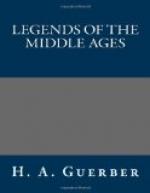The majority of these works were written in French, which was the court language of England in the mediaeval ages; but the story was “Englished” by Malory in the fourteenth century. In every European language there are versions of these stories, which interested all hearers alike, and which exerted a softening influence upon the rude customs of the age, “communicated a romantic spirit to literature,” and taught all men courtesy.
[The Real Merlin] The first of these romances is that of Merlin the enchanter, in very old French, ascribed to Robert de Borron. The following outline of the story is modified and supplemented from other sources. The real Merlin is said to have been a bard of the fifth century, and is supposed to have served the British chief Ambrosius Aurelianus, and then King Arthur. This Merlin lost his reason after the battle of Solway Firth, broke his sword, and retired into the forest, where he was soon after found dead by a river bank.
The mythical Merlin had a more exciting and interesting career, however. King Constans, who drove Hengist from England, was the father of three sons,—Constantine, Aurelius Ambrosius, and Uther Pendragon. When dying he left the throne to his eldest son, Constantine, who chose Vortigern as his prime minister. Shortly after Constantine’s accession, Hengist again invaded England, and Constantine, deserted by his minister, was treacherously slain. In reward for his defection at this critical moment, Vortigern was offered the crown, which he accepted, and which he hoped to retain, although Constans’s two other sons, who, according to another version of the story, were called Uther and Pendragon, were still in existence.
To defend himself against any army which might try to deprive him of the throne, Vortigern resolved to build a great fortress on the Salisbury plains. But, although the masons worked diligently by day, and built walls wide and thick, they always found them overturned in the morning. The astrologers, when consulted in reference to this strange occurrence, declared that the walls would not stand until the ground had been watered with the blood of a child who could claim no human father.
Five years previous to this prediction, the demons, seeing that so many souls escaped them owing to the redemption procured by a child of divine origin, thought that they could regain lost ground by engendering a demon child upon a human virgin. A beautiful, pious maiden was chosen for this purpose; and as she daily went to confess her every deed and thought to a holy man, Blaise, he soon discovered the plot of the demons, and resolved to frustrate it.
[Sidenote: Birth of the mythical Merlin.] By his advice the girl, instead of being immediately put to death, as the law required, was locked up in a tower, where she gave birth to her son. Blaise, the priest, more watchful than the demons, no sooner heard of the child’s birth than he hastened to baptize him, giving him the name of Merlin. The holy rite annulled the evil purpose of the demons, but, owing to his uncanny origin, the child was gifted with all manner of strange powers, of which he made use on sundry occasions.




